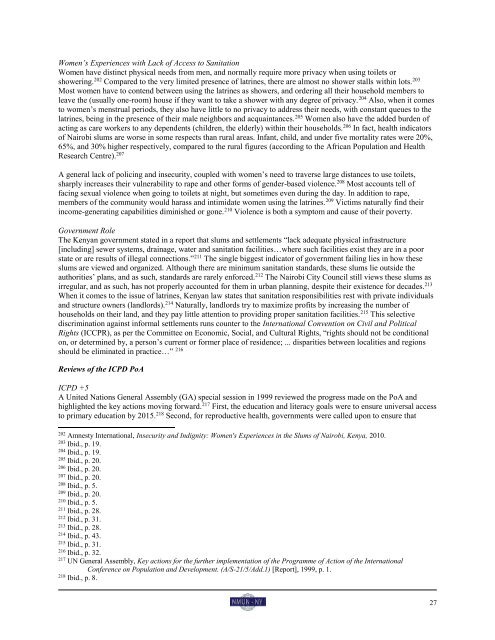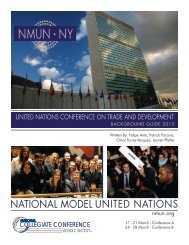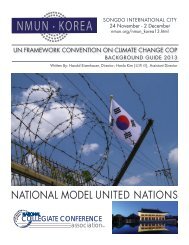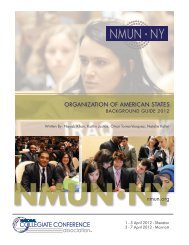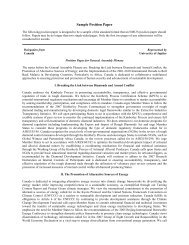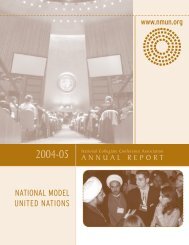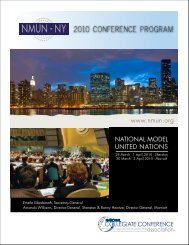UNFPA Background Guide - National Model United Nations
UNFPA Background Guide - National Model United Nations
UNFPA Background Guide - National Model United Nations
Create successful ePaper yourself
Turn your PDF publications into a flip-book with our unique Google optimized e-Paper software.
Women’s Experiences with Lack of Access to Sanitation<br />
Women have distinct physical needs from men, and normally require more privacy when using toilets or<br />
showering. 202 Compared to the very limited presence of latrines, there are almost no shower stalls within lots. 203<br />
Most women have to contend between using the latrines as showers, and ordering all their household members to<br />
leave the (usually one-room) house if they want to take a shower with any degree of privacy. 204 Also, when it comes<br />
to women’s menstrual periods, they also have little to no privacy to address their needs, with constant queues to the<br />
latrines, being in the presence of their male neighbors and acquaintances. 205 Women also have the added burden of<br />
acting as care workers to any dependents (children, the elderly) within their households. 206 In fact, health indicators<br />
of Nairobi slums are worse in some respects than rural areas. Infant, child, and under five mortality rates were 20%,<br />
65%, and 30% higher respectively, compared to the rural figures (according to the African Population and Health<br />
Research Centre). 207<br />
A general lack of policing and insecurity, coupled with women’s need to traverse large distances to use toilets,<br />
sharply increases their vulnerability to rape and other forms of gender-based violence. 208 Most accounts tell of<br />
facing sexual violence when going to toilets at night, but sometimes even during the day. In addition to rape,<br />
members of the community would harass and intimidate women using the latrines. 209 Victims naturally find their<br />
income-generating capabilities diminished or gone. 210 Violence is both a symptom and cause of their poverty.<br />
Government Role<br />
The Kenyan government stated in a report that slums and settlements “lack adequate physical infrastructure<br />
[including] sewer systems, drainage, water and sanitation facilities…where such facilities exist they are in a poor<br />
state or are results of illegal connections.” 211 The single biggest indicator of government failing lies in how these<br />
slums are viewed and organized. Although there are minimum sanitation standards, these slums lie outside the<br />
authorities’ plans, and as such, standards are rarely enforced. 212 The Nairobi City Council still views these slums as<br />
irregular, and as such, has not properly accounted for them in urban planning, despite their existence for decades. 213<br />
When it comes to the issue of latrines, Kenyan law states that sanitation responsibilities rest with private individuals<br />
and structure owners (landlords). 214 Naturally, landlords try to maximize profits by increasing the number of<br />
households on their land, and they pay little attention to providing proper sanitation facilities. 215 This selective<br />
discrimination against informal settlements runs counter to the International Convention on Civil and Political<br />
Rights (ICCPR), as per the Committee on Economic, Social, and Cultural Rights, “rights should not be conditional<br />
on, or determined by, a person’s current or former place of residence; ... disparities between localities and regions<br />
should be eliminated in practice…” 216<br />
Reviews of the ICPD PoA<br />
ICPD +5<br />
A <strong>United</strong> <strong>Nations</strong> General Assembly (GA) special session in 1999 reviewed the progress made on the PoA and<br />
highlighted the key actions moving forward. 217 First, the education and literacy goals were to ensure universal access<br />
to primary education by 2015. 218 Second, for reproductive health, governments were called upon to ensure that<br />
202<br />
Amnesty International, Insecurity and Indignity: Women's Experiences in the Slums of Nairobi, Kenya, 2010.<br />
203<br />
Ibid., p. 19.<br />
204<br />
Ibid., p. 19.<br />
205<br />
Ibid., p. 20.<br />
206<br />
Ibid., p. 20.<br />
207<br />
Ibid., p. 20.<br />
208<br />
Ibid., p. 5.<br />
209<br />
Ibid., p. 20.<br />
210<br />
Ibid., p. 5.<br />
211<br />
Ibid., p. 28.<br />
212<br />
Ibid., p. 31.<br />
213<br />
Ibid., p. 28.<br />
214<br />
Ibid., p. 43.<br />
215<br />
Ibid., p. 31.<br />
216<br />
Ibid., p. 32.<br />
217<br />
UN General Assembly, Key actions for the further implementation of the Programme of Action of the International<br />
Conference on Population and Development. (A/S-21/5/Add.1) [Report], 1999, p. 1.<br />
218<br />
Ibid., p. 8.<br />
27


